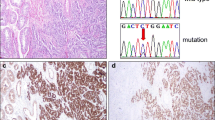Abstract
SOX-9, an essential factor for male sexual development, can be induced by prostaglandin D2 in a Sry-independent mechanism. Recent data suggest that the hedgehog pathway is involved in the differentiation of normal Sertoli and Leydig cells. The purpose of our study was to investigate the mechanisms involved in the differentiation of ovarian sex cord-stromal tumour (SCST) cells. Two Sertoli–Leydig cell tumours and two granulosa cell tumours with a minor Sertoli element were studied using immunohistochemistry on paraffin-embedded tissue sections. Sertoli cells expressed anti-Mullerian hormone (AMH), SOX-9, prostaglandin D synthase (Pgds) and bcl-2 (in four of four cases); sonic hedgehog (Shh) and p53 (in three of four cases) and androgen receptors (AR; in one of four cases). Ki-67 index ranged from 10% to 50%. Leydig cells expressed Shh and AR (two of two cases), while they showed no expression of p53, bcl-2 and 0% Ki-67 index. Granulosa cells expressed AMH, Pgds, Shh, estrogen receptors, progesterone receptors, AR and bcl-2 (in two of two cases) and p53 (in one of two cases). Ki-67 index was 10% and 40%, respectively. Further investigation is required to clarify the role of the molecules outlined above in the histogenesis of ovarian SCST, as Pgds-mediated SOX-9 upregulation could provide a reasonable explanation for the presence of testicular differentiation in ovarian SCST.







Similar content being viewed by others
References
Baker PM, Oliva E (2004) Immunohistochemistry as a tool in the differential diagnosis of ovarian tumors: an update. Int J Gynecol Pathol 24:39–55
Bishop CE, Whitworth DJ, Qin Y et al (2000) A transgenic insertion upstream of Sox9 is associated with dominant XX sex reversal in the mouse. Nat Genet 26:490–494
Colombo N, Parma G, Franchi D (1999) An active chemotherapy regimen for advanced ovarian sex cord-stromal tumors. Gynecol Oncol 72:129–130
De Santa Barbara P, Bonneaud N, Boizet B et al (1998) Direct interaction of SRY related protein SOX9 and steroidogenic factor 1 regulates transcription of the human anti- müllerian hormone gene. Mol Cell Biol 18:6653–6665
Emerson RE, Wang M, Roth LM et al (2007) Molecular genetic evidence supporting the neoplastic nature of the Leydig cell component of ovarian Sertoli–Leydig cell tumors. Int J Gynecol Pathol 26(4):368–74
Genton CY (1980) Ovarian sertoli-leydig cell tumors. A clinical, pathological and ultrastructural study with particular reference to the histogenesis of these tumors. Arch Gynecol 230:49–75
Hirakawa M, Nagai Y, Yagi C et al (2007) Recurrent juvenile granulosa cell tumor of the ovary managed by palliative radiotherapy. Int J Gynecol Cancer 18(5): 913–915
Hittmair A, Zelger BG, Obrist P et al (1997) Ovarian Sertoli–Leydig cell tumor: a SRY gene-independent pathway of pseudomale gonadal differentiation. Hum Pathol 28(10):1206–1210
Kostopoulou E, Talerman A (2003) Ovarian Sertoli–Leydig cell tumor of intermediate differentiation with immature skeletal muscle heterologous elements. Acta Obstet Gynecol Scand 82:197–198
Malki S, Bibeau F, Notarnicola C et al (2007) Expression and biological role of the prostaglandin D synthase/SOX9 pathway in human ovarian cancer cells. Cancer Lett 255:182–193
Mooney E, Man Y, Bratthauer G et al (1999) Evidence that Leydig cells in Sertoli–Leydig cell tumors have a reactive rather than a neoplastic profile. Cancer 86:2312–2319
Nouriani M, Felix JC, Dubeau L (2002) Histogenesis and histopathological characteristics of Sertoli–Leydig cell tumors. CME J Gynecol Oncol 7:114–120
Palmer SJ, Burgoyne PS (1991) In situ analysis of fetal, prepuberal and adult XX–XY chimaeric mouse testes: Sertoli cells are predominantly, but not exclusively, XY. Development 112:265–268
Ross AJ, Capel B (2005) Signaling at the crossroads of gonad development. Trends Endocrinol Metab 16(1):19–25
Scully RE (1982) Sex cord-stromal tumors. In: Blaustein A (ed) Pathology of the female genital tract. 2nd edn. Springer, New York, pp 581–601
Sekido R, Bar I, Narváez V et al (2004) SOX9 is up-regulated by the transient expression of SRY specifically in Sertoli cell precursors. Dev Biol 274:271–279
Sharpe RM, McKinnell C, Civlin C et al (2003) Proliferation and functional maturation of Sertoli cells, and their relevance to disorders of testis function in adulthood. Reproduction 125:769–784
Truss L, Dobin SM, Rao A et al (2004) Overexpression of the BCL2 gene in a Sertoli–Leydig cell tumor of the ovary: a pathologic and cytogenetic study. Cancer Genet Cytogenet 148:118–122
Vidal V, Chaboissier M, de Rooij D et al (2001) Sox9 induces testis development in XX transgenic mice. Nat Genet 28:216–217
Weenen C, Laven JSE, von Bergh ARM et al (2004) Anti-Mullerian hormone expression pattern in the human ovary: potential implications for initial and cyclic follicle recruitment. Mol Hum Reprod 10(2):77–83
Wilhelm D, Martinson F, Bradford S et al (2005) Sertoli cell differentiation is induced both cell-autonomously and through prostaglandin signaling during mammalian sex determination. Dev Biol 287:111–124
Wilhelm D, Palmer S, Koopman P et al (2007) Sex determination and gonadal development in mammals. Physiol Rev 87:1–28
Acknowledgments
The authors would like to thank Dr Alexandra Jane Cooke for her invaluable help on reviewing, and correcting the manuscript where necessary.
The authors would like to declare that they have no conflict of interest.
Author information
Authors and Affiliations
Corresponding author
Rights and permissions
About this article
Cite this article
Papanastasopoulos, P., Repanti, M., Damaskou, V. et al. Investigating differentiation mechanisms of the constituent cells of sex cord-stromal tumours of the ovary. Virchows Arch 453, 465–471 (2008). https://doi.org/10.1007/s00428-008-0677-7
Received:
Revised:
Accepted:
Published:
Issue Date:
DOI: https://doi.org/10.1007/s00428-008-0677-7




